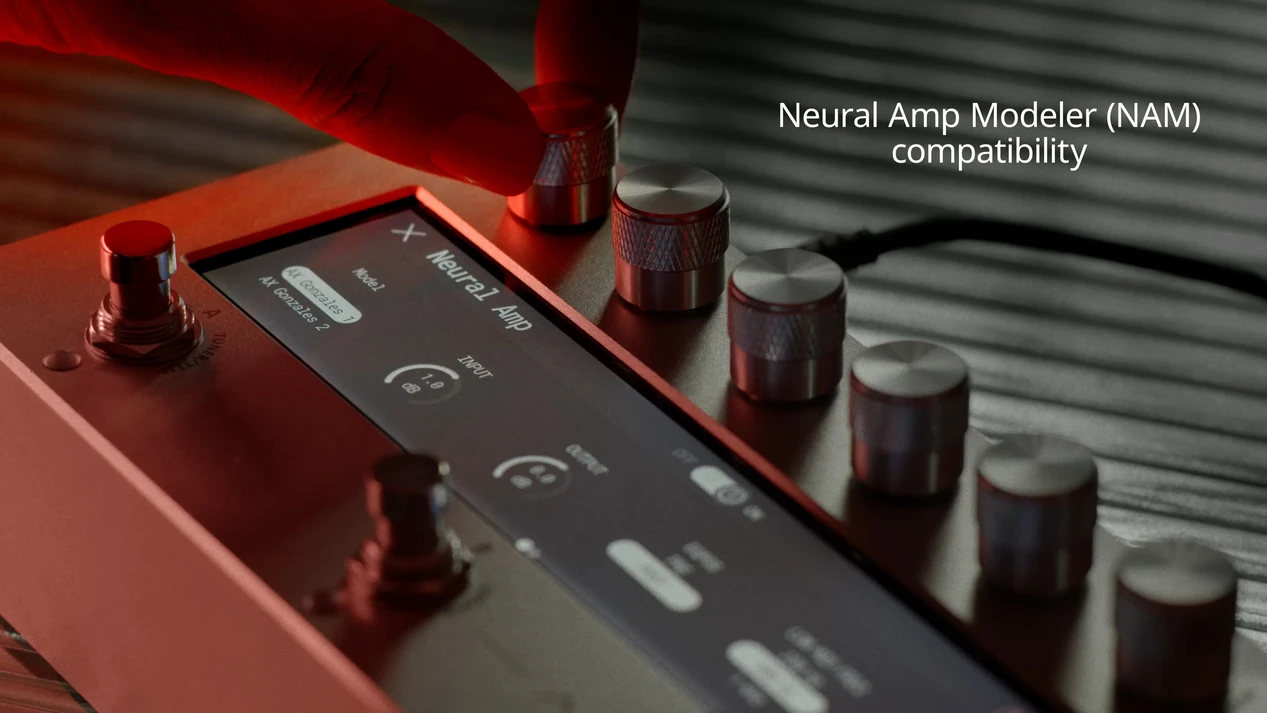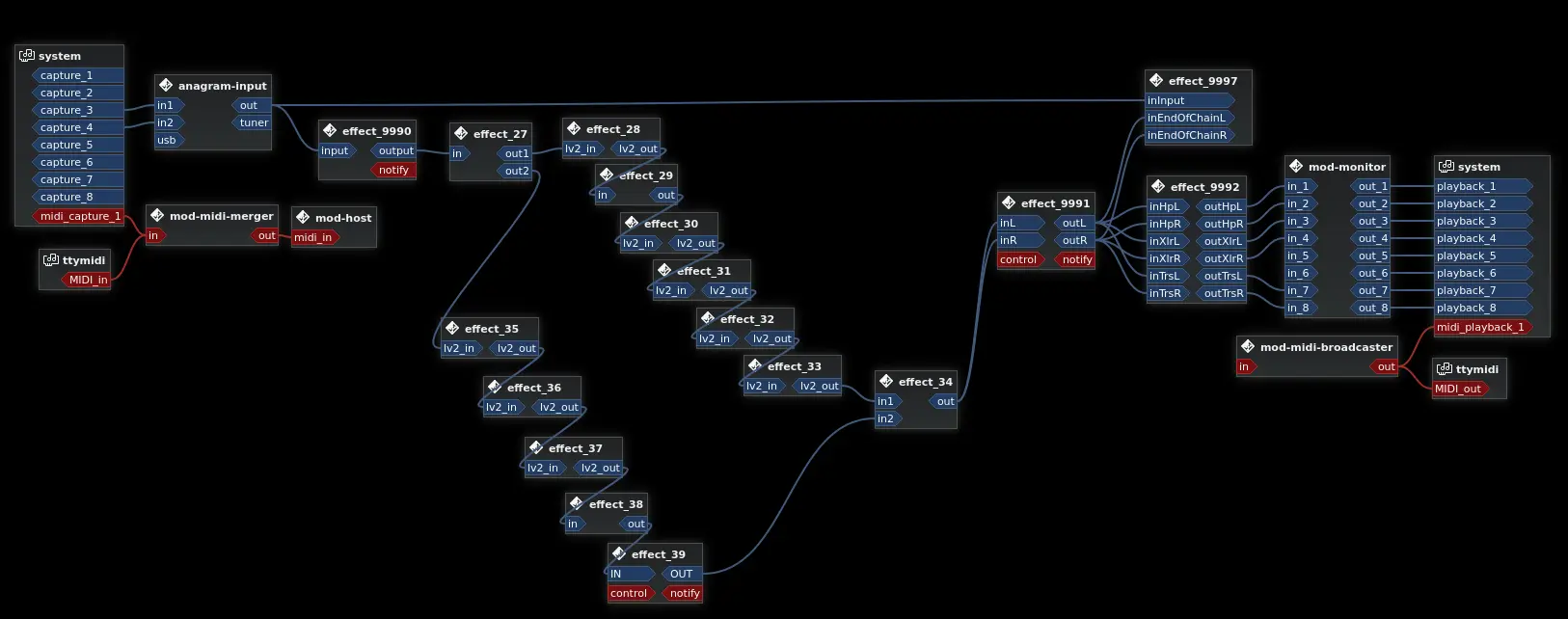Darkglass Electronics, a popular maker of bass-centric equipment (pedals, amps, cabinets), announced their first multi-effects box earlier this week. Anagram is a relatively compact pedal with a touch screen for setting up the signal chain, six endless encoders, and three footswitches.
Inside, it packs a curation of effects, as well as amp and cabinet simulations—through neural models and IRs. Oh, and it’s running embedded Linux.
The UI seems to be well thought-out. FX controls are easy to access. You can even do things like splitting the signal chain, although the narrow display can only show one row at a time.
If punching footswitches and tweaking encoders is not your thing, Anagram is supported by Darkglass Suite, a desktop librarian for other company’s gear (no Linux version, but Android/iOS versions are available).
Anagram’s neural amp can load both NAM and AIDA-X models—both open-source projects, both with various UIs available as plugins for desktop DAWs.

The focus on neural modeling shouldn’t surprise you. It’s the latest tech that people are really excited about, and for a good reason.
Coincidentally, Darkglass and Neural DSP Technologies, the maker of Quad Cortex and Nano Cortex, share a co-founder, Douglas Castro (no longer around at Darkglass). You could probably think of Anagram as a bass-focused sibling in the Cortex family. Well, a cousin twice removed, maybe? At a price point exactly in the middle between the Quad and the Nano.
If you dig a little deeper, there’s a lot of fun trivia there. Yes, Darkglass and Neural DSP Technologies have the same co-founder. Darkglass was acquired by Korg several years ago, but Neural DSP Technologies remains independent. However, Korg also owns Aguilar—another bass equipment household name. An Aguilar DB amp makes a cameo appearance in one of the Anagram product videos. I wouldn’t be too surprised if there was some cross-pollination between the two companies.
There’s already at least a dozen reviews on YouTube. If you feel brave enough, you can start with the official deep dive video (1h+ long).
Anyway, Linux-based?
Ay. It’s running on Linux (Buildroot-based if you care, with the MOD Build System layer on top of it), uses JACK2 for audio server together with mod-host, and relies on LV2 plugins for effects—I’ll get back to that in a minute. Darkglass published extensive information on licenses and source code modifications.
If you’ve been around Linux audio long enough, it shouldn’t surprise you that the latency is really good. With Anagram, you can go as low as 1.3ms of total i/o roundtrip latency at 16 frames / 48kHz with “static” effects like the global EQ, mixer, and looper, and a bunch of extra plugins.

The setup on the screenshot above (courtesy of Filipe Coelho) isn’t exactly telling because you don’t get to see what plugins those are. But that preset runs with around 30% CPU load.
Apart from running proprietary plugins (mostly LV2 versions of Darkglass’s own pedals), Anagram has some open-source ones. The global EQ is fil4.lv2 by Robin Gareus, but you probably wouldn’t recognize it.

The spectrum analyzer is actually modspectre.lv2, also by Robin, together with Filipe.
The built-in looper is based on the sooperlooper by Jesse Chappell, and you wouldn’t recognize it either.

That’s the power of LV2: you can separate the logic from the UI and build entirely new interfaces. And since you are here for the gory penguin details, Anagram’s UI is built with LVGL.
How good is it for 1K EUR?
I don’t have any hands-on experience with it, and gear channels on YouTube are not necessarily a great indicator. But they seem to be loving it so far.
Based on several demos I listened to, the processing quality is convincing. You can check out this video by Nate Navaro; he doesn’t cover the cons much (if at all), but he plays at least as much as he talks:
And because you can load neural profiles for whatever gear, people are already starting to use Anagram for instruments other than the bass. Here is a video by Leo Gibson:
Will this be an open platform?
That remains to be seen. It kinda makes sense that Darkglass would at least try to create a marketplace and thus open the platform to 3rd-party developers. But there is no word on that yet.
Korg, as a parent company, does have experience creating an open platform for plugin developers. You can get 3rd-party plugins for their Prologue, Minilogue XD, NTS-1, NTS-1 mkII, and NTS-3 synths and effect kits. Or develop your own ones. There are some very nice ones available.
MOD Devices, where much of the tech is coming from (I’ll get to that in a minute, too), has a lot of experience building an open platform as well. They developed their own web-based toolkit for LV2 plugins and a toolchain for developers.
Where is this all coming from?
The Anagram team has drawn directly from MOD Devices, a startup company by Gianfranco Ceccolini et al. MOD built several multi-FX boxes, most recently Dwarf, targeted primarily at guitar players but also used by other musicians (Peter Kirn of CDM fame is one of the fans).
MOD Devices came up with the idea that you can build an open platform for loading effects and do it all in a browser. They used embedded Linux, a custom LV2 host application, and a metric crapton of LV2 plugins to build a strong platform. All in all, it was a great concept and a decent implementation (although not without its flaws).
Alas, the company wasn’t very successful. COVID-19 messed up the supply chain really badly, which triggered a multi-year crisis from which the company hasn’t recovered yet and probably never will.
In September 2024, Gianfranco announced on the forum: “We’ve sold some of our software assets to industry peers and our staff is now working part-time on these collaborations”. We now know what he meant by that, exactly.
In fact, you can see both Gianfranco Ceccolini and Filipe Coelho (MOD employee and developer of Carla, DPF, and Cardinal, among other things) in the Anagram back story video.
What do we, as Linux users, get out of all this? Darkglass has already given the code modifications back to the community. But can I interest you in a completely misplaced sense of pride? I mean, Jordan Rudess plays Linux-powered keyboards by Korg. John Petrucci plays a Linux-powered Quad Cortex. So maybe get John Myung to play Anagram, and you could claim that Dream Theater is an all-penguin band. Or not.
Patreon subscribers get early access to my posts. If you are feeling generous, you can also make a one-time donation on BuyMeACoffee.

